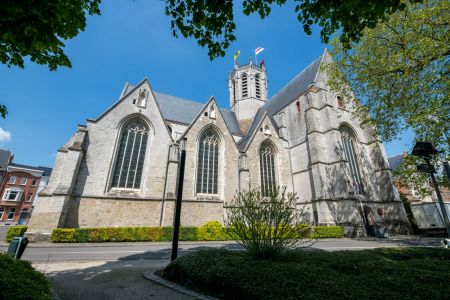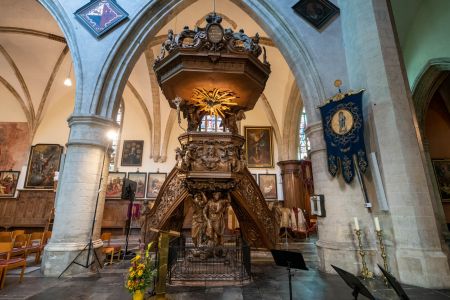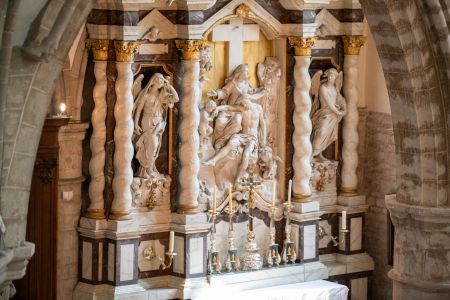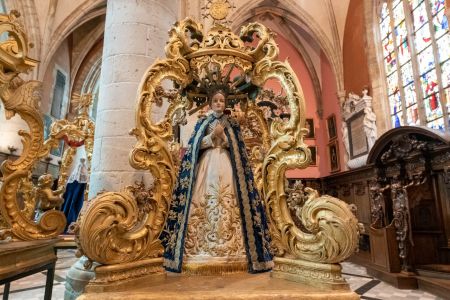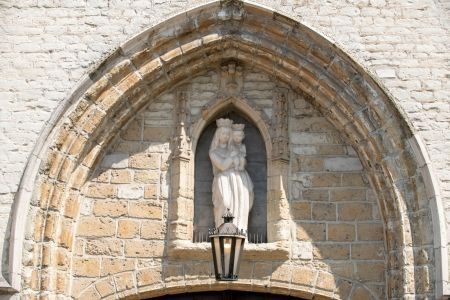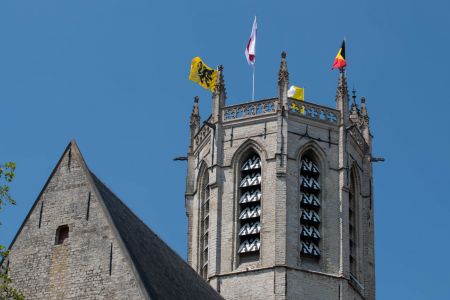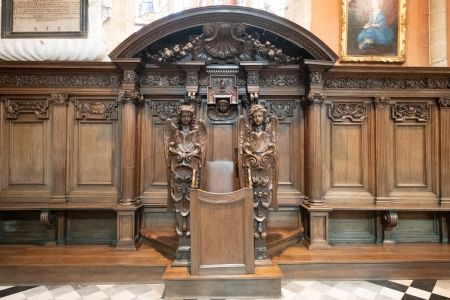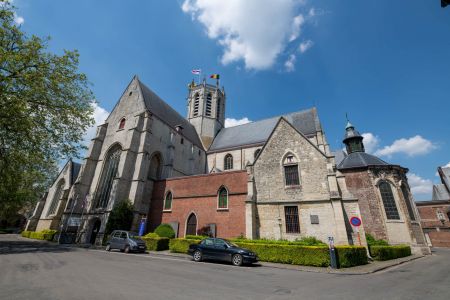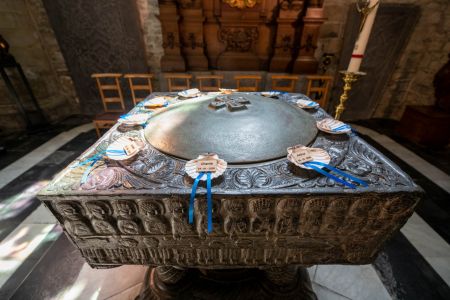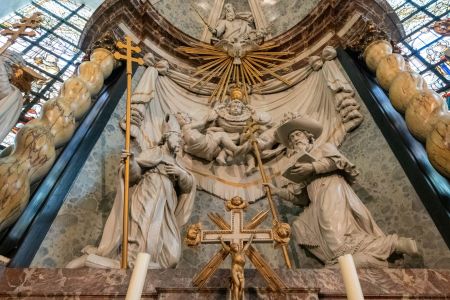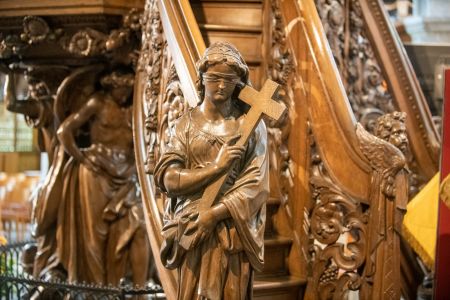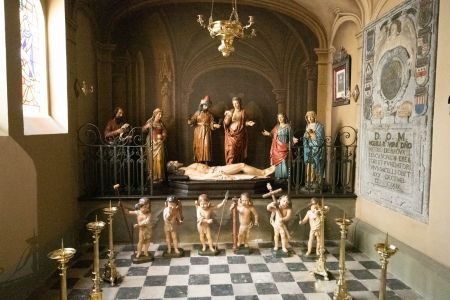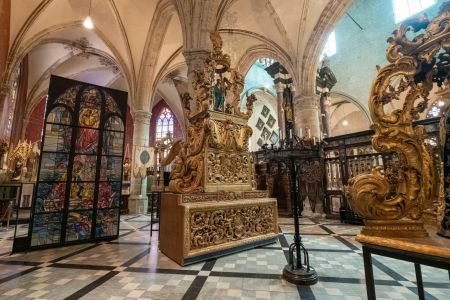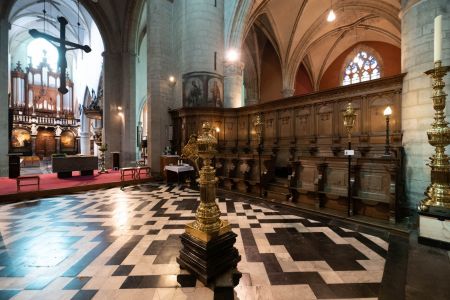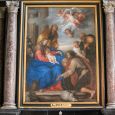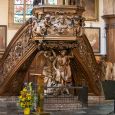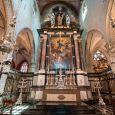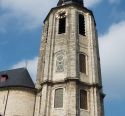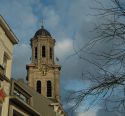Church | XIII-XV | | Catholic Church

Map
Opening hours
01 June - 30 September
Mon -
Tue 13.00 - 17.00
Wed 13.00 - 17.00
Thu 13.00 - 17.00
Fri 13.00 - 17.00
Sat 13.00 - 17.00
Sun 13.00 - 17.00
Guided tour
Religious offices
Description
Flemish masters like Antoon van Dyck, Gaspar de Crayer and David Teniers the Elder have found their home here in this church. The work ‘The Adoration of the Shepherds’ by Antoon van Dyck was specifically painted for this church, and was made to order in 1631 by the Brotherhood of Our Lady. The showpiece of this church is a roman baptismal font in Tournai Stone. The visitor further gets to see a sculpted pulpit, a marble main altar, a Van Peteghem organ, and several worthwhile murals. The church treasury consists of, amongst others, a masterpiece of goldsmith's art: a reliquary with sapphires from about 1220-1230.
We presume that Ringoot II, lord of Dendemonde, had the church built during the 11th century. Many renovations took place from the 13th to the 16th century. The most important parts of the church were built in Scheldt Gothic style. The eight-sided tower on the crossing, where ship and transverse panels cross each other, dates from 1388. The stubby spire was replaced by a tall wooden spire during 1910-1912. During a stormy night at the end of 1940, the wooden spire blew away never to be replaced again.
After the devastation that took place during the Calvinist period (1578-1584), new furniture was added in renaissance and baroque style. During the 19th century and the beginning of the 20th century, several parts of the church were changed, partially also in Neo-Gothic style. Since 1948, the non-profit organisation Friends of the church of Our Lady has been watching over this building. They remind the visitors that he or she is walking in the footsteps of Margaret of York, who visited the church on July 23, 1468. This was also when her coat of arms was attached to a vault key. You are now using the guestbook.
KIKIRPA : photo-library online
Visit Dendermonde
Photos
Remarkable elements
Masterpieces by Antoon Van Dyck
The church has two masterpieces by Anthony Van Dyck (1599-1641). They are both located in two southern side chapels. The “Calvary” (1628-1629) was intended for the high altar of the former Capuchin church and was a gift from Bishop Antoon Triest (1577-1657). The “Christmas Night” (1631) was commissioned for the altar of the Lady Chapel by the Brotherhood of Our Lady. It still adorns the original portico altar (1629), created by the workshop of Hieronymus Duquesnoy the Elder and Antoon Faydherbe. Both works have recently been restored.
Baptismal font
The Romanesque baptismal font in Tournai limestone dates from the second half of the 12th century and originates from the predecessor of the current church. The sculpture on the basin is particularly remarkable. In addition to two friezes depicting griffins (evil) and the Lamb of God (good), two other friezes are particularly noteworthy. One depicts the baptism of Paul, who is shown alongside Peter next to Heavenly Jerusalem. The second depicts Paul's admission into the community of the apostles. This extremely remarkable Romanesque baptismal font was restored in 1859-1860 and placed in the baptistery, which was then closed off with an oak partition (1635-1637) from the former St. Hilduardus choir.
Pulpit
The Baroque pulpit dates from 1680-1682 and is the work of Antwerp sculptor Mattheus Van Beveren the Elder (1639-1696). The pulpit is supported by three life-size angels trampling on unbelief. The reliefs on the pulpit depict Christ in the centre, God the Father on the left and Our Lady on the right. The same sculptor also created the altar of Saint Barbara and Our Lady of Seven Sorrows (1668-1669) with a central Pietà.
Main altar
The Baroque high altar in the chancel was probably designed by Hans van Mildert and made by Huybrecht vanden Eynde. It is crowned by Christ Salvator Mundi with the city's patron saints, St. Hilduardus and St. Christiana. The front features a painting by Gaspar de Crayer (1584-1969) depicting “The Glorification of Our Lady” (1633-1635). The painting on the back depicts the “Presentation in the Temple” and is attributed to Jan van Cleef (1646-1716).
Wall paintings
The Church of Our Lady also boasts some remarkable murals. In the northern transept, a Calvary from the second quarter of the 15th century has been preserved, which originally also included a carved Calvary, complete with Christ on the cross. In the northern aisle, a vault painting has been preserved around a keystone bearing the coat of arms of Margaret of York, added in memory of her visit on 23 July 1468. In the chancel, we find several murals (15th-17th century) depicting the apostles and the canons Jacobus and Joannes Van der Meere.
Organ
The impressive organ is a combination of the organ delivered by Jan van Loo in 1654-1656 and that of Mamimiliaan Van Peteghem, who renovated and expanded it in 1860-1861 with two large side towers. The organ stands on the former marble gallery, designed by Huybrecht vanden Eynde and realised by stonemason Adriaan van Ronse and sculptors Artus Quellinus and Mattheus van Beveren (statues of the four evangelists). It was placed against the west façade in 1860 to serve as an organ loft.
Partners
Nearby
Circuit
Dendermonde: lordly churches and chapels
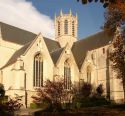
Religious heritage around Dendermonde-Buggenhout – With this cycle route we zoom in on the influence of the secular lords in the creation of churches and chapels and on their role as patrons of various religious institutions. This is the land of the mighty medieval lords of Dendermonde!



